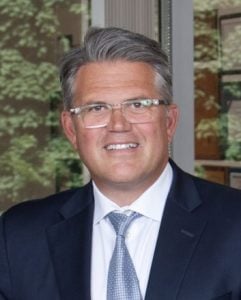“Imagine a patriarch and matriarch sitting around my conference room table. They’re in their 80s. They’re healthy, they’re doing good. They’ve educated their kids and the kids are doing great, and, in fact, the grandkids are on their way, doing well,” says Peter Klein, founder and CIO of ALINE Wealth and president of the Claire Friedlander Family Foundation. “They say to me, I want the large part of my capital, my cash, my investment to go into a fund, maybe a foundation—oftentimes, it’s a foundation—where my kids, grandkids and the future great-grandkids can understand who we were.”
“Now, fast forward a couple years later,” he continues. “They’re a little bit older, still fine. They’re around the dining room table at Thanksgiving. And they see and they hear their great-grandson talk about how he volunteered at one of the nonprofits that has been near and dear to their heart for many years, or another grandchild maybe is researching an area that they want to maybe give to, perhaps a particular disease or particular issue, environment, whatever. And this particular grandchild is getting their hands into the weeds a bit and has convened a few experts to learn about this. And now, the grandfather, the grantor, the guy who made the money is sitting back saying, ‘Mission accomplished.’ Those kids will tell their kids who grandpa and grandma were and what they stood for and how all this happened—how their philanthropic legacy was created and is being still fed and nourished with each new generation.”

 And Klein would know. As president of the Claire Friedlander Family Foundation, it’s his job to determine how to continue her legacy in ways that would be most befitting to her and her interests when she was alive. Klein calls his work “legacy planning” and refers to him and his team’s work at ALINE Wealth as being that of “legacy agents.” Klein (pictured right) video chatted with Worth about his work at the Claire Friedlander Family Foundation, how its portfolio strategy and that of ALINE Wealth’s has managed to navigate the last decade with reduced risks and higher-than-expected returns and what worth beyond wealth means to him and his work.
And Klein would know. As president of the Claire Friedlander Family Foundation, it’s his job to determine how to continue her legacy in ways that would be most befitting to her and her interests when she was alive. Klein calls his work “legacy planning” and refers to him and his team’s work at ALINE Wealth as being that of “legacy agents.” Klein (pictured right) video chatted with Worth about his work at the Claire Friedlander Family Foundation, how its portfolio strategy and that of ALINE Wealth’s has managed to navigate the last decade with reduced risks and higher-than-expected returns and what worth beyond wealth means to him and his work.
Q: To start, can you tell me a little bit about your work in running ALINE Wealth and the Claire Friedlander Family Foundation?
A: I wear two hats. I serve as chief investment officer and founder of ALINE Wealth, which is a wealth management firm. I’ve been a financial advisor for 34 years. But 12, 13 years ago, one of my clients was getting older, came to me and said, “You’ve made me a lot of money over the last 15 years of our working relationship. And I gave you a chance when you were a young, beginning financial advisor, and you took care of me and you grew my assets. Now I need your help,” she says, “to give this money away,” because she was alone, she had no family. And I thought I did what any good financial advisor would do with their top client, is say, “Of course, I’m here to help, what do I need to do?” And Claire Friedlander had suggested that I introduce her, make meetings for her and various different nonprofit organizations that she had interest in. At the time, I thought I was just doing good service for my client. But I later realized that I was being groomed to be her legacy agent for when she passed a few years later. I was told by the estate attorneys to start, manage and run this foundation in her honor, which I still do today. It’s a privilege, and it’s a weighty responsibility, but a privilege, nonetheless.
We’ve been giving away Miss Friedlander’s assets over time and growing the corpus, as well. And it’s been great. We’ve given away a million dollars a year for the last 10 years, and the portfolio is still growing, and we have a lot more to do, and especially during this COVID period, we’ve pivoted a bit to focus more on health-related and medical research and food insecurity nonprofits. That should give you a sense of my dual mission, with the financial advisory role that led to the philanthropic role.

This notion of a legacy agent is as I described it to you. Allow me to use this thought experiment to frame it. If I were to ask you to name first names of your eight great grandparents, how many of you think you’d be able to get?
Not one.
Yeah, most people get zero to two. And that’s where we come in, we come in to help the patriarch and the matriarch of the family establish a fund or a portfolio or foundation or some kind of legacy, so that their kids, grandkids, great-grandkids and great-great-grandkids understand their values and their dreams and what they were interested in, how they worked hard to make this capital and what they think they should be doing with it when they’re no longer here…this notion of a legacy agent grew out of that work that we do in our practice that helps our clients every day.
So, what exactly is the role of a legacy agent?
You know, it’s a term that I sort of coined, so I don’t know if there’s any definitive definition to it, and maybe I didn’t coin it, maybe someone else did, and I didn’t realize it. But I started using it about 10 years ago, when I started describing this role that I was in, whereby I’m getting tapped on the shoulder to be this now-deceased client’s legacy or vehicle going forward. I guess if I were to describe it, it would be somebody who’s able to help someone with means maintain their value statement and their work ethic or interest or various different charitably minded areas for the next generation and generations thereafter.
The way I look at it, the legacy agent is the in-between, you know, in between a function of the grantor—the one who made this money and now wants to have it as a legacy for the future—and the beneficiaries that will be years later. And oftentimes, those beneficiaries are charitable entities, nonprofit organization, but sometimes it can be actual family.
How is the portfolio strategy for the foundation different from what you do at ALINE Wealth?
Well, there is no difference. Just in the case of the foundation, I guess, I’m the client, right? I mean, the foundation is a client, but I’m the president of the foundation. At the end of the day, I report to my board how the foundation’s assets have been managed. And fortunately, we’ve managed them splendidly. We’ve taken on little risk but made pretty good return. So, our risk-adjusted return is pretty high. And that’s how I gauge this. You know, it’s not a gauge of how much money you have made, it’s all about how much risk you’ve taken to make that money. So, I look at that—risk adjusted returns—and the board looks at that, as well.
At ALINE Wealth, we manage about $800 million of other people’s money from foundations to endowments to individuals. And so, we go through a defined process of identifying the individual’s or the organization’s objectives and constraints. We understand deeply their emotionality of what they’re interested in and what they’re not interested in and what some of the unique circumstances might be. We codify all this data in something called an investment policy statement—a bullet-pointed, very straightforward document that’s updated every couple of years that says, “Hey, this is what you told us, you’re looking for capital appreciation, you’re moderate risky, you want to stay away from anything to do with alcohol or chemical companies or whatever it may [be], fossil fuel companies.” We talk about liquidity needs, tax needs, etc. And then from that investment policy statement, we define and formulate a portfolio that is comprised of both index or passively managed instruments that cover the entire spectrum of investing from stocks to bonds to international, domestic—big and small—agriculture commodities, gold, silver, the whole ball of wax. And then around that core portfolio of index solutions, we populate the portfolio with satellite investments or actively managed ideas or themes. One of the themes we focused on some time ago, which has been very lucrative and environmentally savvy has been the idea of the water sector—investing in the pipes, the pumps, the valves, the infrastructure, the testing, the desalination. The host of companies in that entire supply chain that have done very well and are interesting companies. Of course, water is a critical component. So, we’re looking at these themes, we couple those themes with an index portfolio, and we manage the portfolio accordingly. Finally, and something that I believe we are on the forefront of, is to include in the IPS and addendum focused on the entity’s—be it a foundation or a family—mission. Yes, mission—what they care about, what they are disturbed about and what those data points mean as it relates to their portfolio holdings. It is critical that our portfolios remain aligned with our client’s values and interests.
At the foundation, how do you choose which nonprofits you will invest in? Is it a case-by-case situation or is there specific criteria that needs to be met?
Good question. So, putting on my foundation hat, the board and I have monthly or every two-month meetings. We don’t take unsolicited grant requests because we’d be inundated. We’re a small, $15-million foundation, but we do indeed think of our grantees as partners, and as such, we assist them in their operations and fundraising so they can have the all-important impact we are all seeking. Miss Friedlander was eclectic in her interests—remember, that’s how I got involved in this—she would ask me, “Make a meeting with this kind of organization or an organization in this field.” And I would just find those nonprofits, so she knew that I knew her interests. And so, things like dentistry, oral health; she was not a dentist, but she was very interested in that. She was very interested in arts and performing arts, Italian culture and language. She was very interested in education and early education, as well as higher education. Health care has been an area of her interests. We try to be consistent with what she would have been interested in, obviously. But it also proves to be a bit of a challenge because it’s very spread out and very eclectic. So, the board and I have our work cut out for us when it comes to looking for these different organizations to give to, to partner with.
Have you encountered any challenges when it comes to investing in nonprofits during COVID?
I have because we’re investing in stocks and bonds and gold and commodities and trying to round out the portfolio. We’re not here to swing for the fences or hit homeruns. We’re here to keep this money compounding over time for the future of society and the future of giving it away. It’s not our money, and we take our responsibility of managing it very, very carefully. And so that’s been difficult because, as you know, we came into this pandemic, fortunately for the foundation, we had come into this thinking that the market was too high. This [was] back in January. So, we had pulled back our reins. We came into this with a fair amount of defensive posturing, which means that we had a lot of cash and not as much stock. And so, we didn’t suffer as much on the way down. We bought a little bit as the markets came in, but it jumped so quickly, and it’s gotten so heady, and has gotten so frothy, especially in a small grouping of stocks, the tech stocks, that we really are shaking our head at how difficult it is to really try to invest in this market.
In addition to that, typically you have diversification with both stocks and bonds. But bond yields have to come down to zero. I mean, there’s no return in bonds, so you don’t have the ability now to sort of diversify the portfolio and balance it out. And that has caused another degree of concern and difficulty. It’s difficult. Fortunately for us, we’ve performed and, and we’ve performed largely due to being careful and strategic in our deployment. And again, we’re not swinging for the fences, right? We’re not looking to get in home runs, but we’ve been fortunate that we’ve been focused and look, you know, it’s not easy because the markets have gone so haywire, but we believe that the best approach is one that is cautious right now and careful.
What investing advice you would give to those who are trying to invest in nonprofits or are running their own foundations right now?
I wrote a book about investing in foundations and philanthropy, and I’m not going to suggest the book as being the sort of cure-all, but it certainly does help. But I mean, my thinking on this topic is as follows. What a wonderful way to do it. It’s not for everybody, you’ve got to have a charitable intent, right? Because this is not your money. So you’re giving this money, and you don’t have to use a foundation, you can use a donor-advised fund, which gives you more anonymity and it’s easier to manage, but you can’t do the same kind of things you could do with a foundation. But the thinking is that if you’re a person of considerable means, there is a reason to consider a foundation or another vehicle for charitable giving. And that is the legacy that is your name, your values, your story living on through giving to society, and giving the way you direct to give even though you’re long gone. And that’s the idea of having these founding documents that say to your heirs and whoever might be running the foundation after you’re gone, “Hey, here’s what I’m interested in. I want to focus on immigrant families coming to the United States and helping them get a leg up because someone did that for me 100 years ago, my great grandparents 100 years ago, and it made a difference in my life and allowed me to give back to society.” Those stories, those legacies, those trips down memory lane definitely resonate with many, many folks.
With respect to current market conditions, it’s difficult. I wrote a piece—it was a couple years ago when interest rates were one or two percent, now they’re zero—about the difficulties that a typical balanced portfolio, a 60 percent stock, 40 percent bond, has right now. Right now, that 40 percent is providing zero; there’s a zero return there. You’re getting no return on the fixed income, so the stocks have got to do all the heavy lifting. And what often happens is that people then go put more and more money into stocks. And so now, your risk level has gone up dramatically, and you don’t realize it until sometimes it’s too late. So, I’d say be careful. Be careful of what we call style drift, be careful of what we call asset allocation drift. Stay focused on the what ifs and the risks that can come about rather than just the sort of shiny new returns and dancing while everybody is listening to the music. The music will stop. There will be issues. Clearly, we saw that. And I think being careful with respect to allocation is the right path to take. Now with that same token, you always have to be open to new ideas and new opportunities and new themes. And I say, study those themes, understand them, do deep, robust homework on them, so you feel comfortable in investing in them. And if you can’t do it yourself, then direct your advisors to help you do it. That’s the other thing I would suggest—seek professional counsel.
That’s great advice. So, final question. Here at Worth, our ethos is “worth beyond wealth.” What does “worth beyond wealth” means to you and your work?
Well, I think it’s the notion of giving back…Beyond wealth is often this notion of legacy and the future and what your name and what your story means to the future, and how it can help people. And you know, this is a government that allows you to deduct your charitable giving—they subsidize your philanthropic work by providing you a tax deduction—that should not be the motivation to do charitable work, but it certainly helps. And you know, the United States is far ahead of any other industrialized country, far ahead, in its percentage of giving from individuals to charity. And it’s always been part of our DNA here in the States, as we know. We don’t want to rely upon the government or any other institution, we want to rely upon ourselves and that individualism is critical to the American spirit. So I do think it’s important to understand what we do and how we do it and why we do it, but it all comes down to legacy and for providing others with the opportunities to grow the pie, as they say, and to provide greater opportunities for folks in the future.







